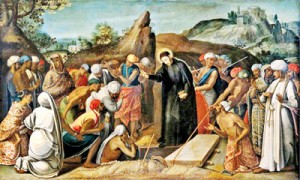St. Xavier in Ceylon and a 17th century painting in Lisbon

St. Francis Xavier restores to life a native of Ceylon: Painted around 1619
The recent discovery of a mass grave in the Mannar district was traced to the period of Portuguese colonial administration and occupation of this part of the country. The findings in the US could only fix a date of 1500-1700.
The arrival of the Portuguese in Sri Lanka in 1505 coincided with the height of the Renaissance in Europe which no doubt included Portugal as well as its capital Lisbon, a renowned centre of learning and the arts.
Because of its privileged position as a major trading centre, to the East and the New World, Lisbon was open to a constant flow of new information, cultures, and finance all of which generated some of the best works of art of the Renaissance and Baroque period. But examples of paintings representing Sri Lankan scenes and themes are scarce.
One of the few exceptions is the work attributed to the Baroque painter Andre Reinozo (1590-1641?). His work ‘St. Francis Xavier Restores to Life a Native of Ceylon’, an oil painting done in about 1619, depicts one of the miracles attributed to Francis Xavier who was canonized on March 12, 1622.
In this scene, the Jesuit missionary is seen blessing a recently buried body of a young man from Sri Lanka who comes to life after the blessing. The painting shows with vivid realism the colourful variety of Oriental costumes- printed sarees, sarongs, turbans, sashes, headbands, jewellery and ornaments.
Although Reinozo never visited Sri Lanka, much of the details of the Sri Lanka landscape, people and attire seen in the painting were familiar to Portuguese through their travel and other cultural, religious and economic activities with the maritime provinces of Sri Lanka. The design, also the materials of the garments and ornaments worn by the indigenous Sri Lankans were effectively conveyed to Portugal — either through material available in the markets or images published in general literature, and art works. The images were often based on carvings, paintings by local craftsmen who were familiar with these items. Also some of the scenes were composed and or based on sketches made here.
No doubt oral and written reports were given by Jesuits and Franciscan monks who working among the local congregation were all too familiar with the sites of Francis Xavier’s life and regions associated with his missionary activities in Asia.
The series of 20 paintings now in the Sacristy of the Church of San Rocco in Lisbon vividly illustrates these scenes from countries and towns in the Portuguese colonies in Asia including Goa, Sri Lanka, Malacca, Macao and Kobe (Japan).
The Sao Roque (Church of Saint Roch), a Roman Catholic Church is believed to be the earliest Jesuit Church, in the Portuguese world. It survived the massive earthquake that levelled much of Lisbon
in 1755.


